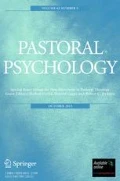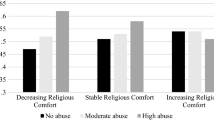Abstract
Based on questionnaires and in-depth interviews, this article describes and systematically analyzes the psychology of the religiosity of contemporary Chinese Buddhist and Christian converts. People convert to a religious faith for a variety of reasons that range from seeking a means of escape to a practical way of coping with life. Religious belief contains subtle and complex factors, such as the interactions between believers and their beliefs, a sense of community among religious believers, conversion of mind and personality, and influence of the religious beliefs on religious believers’ mental health and behavior. This paper seeks to provide an overview of research conducted in the People’s Republic of China about the various motivations and paths to conversion.
Similar content being viewed by others
References
Cornwall, M. (1987). The social bases of religion: A study of factors influencing religious belief and commitment. Review of Religious Research, 29, 44–56.
Jordan, D. K. (1959/1993). The glyphomancy factor: Observations on Chinese conversion. In Robert W. Hefner (ed.), Conversion to Christianity: Historical and anthropological perspectives on a great tradition (pp. 285–304). Berkeley: University of California Press.
Liang, L. (2004). Chinese religious psychology: Religious identity theory, analysis, and empirical research. China: Social Science Literature Press.
Liang, L. (2003). Survey and analysis of religious identification. Studies in World Religions, 3, 34–44.
Liang, L. (2005). The conversion experiences of Chinese: An examination of Buddhists and Christians in Shanxi. Religious Studies, 1, 118–125.
Liang, L. (2006). Social transformation and religious conversion: An investigation with Christians as objects. Studies in World Religions, 2, 72–81.
Lin, Y. (1935/2000). My country and my people. New York: Reynal and Hitchcock.
Lofland, J., & Stark, R. (1965). Becoming a world-saver: A theory of conversion to a deviant perspective. American Sociological Review, 30(6), 862–875.
Lofland, J., & Skonovd, N. (1981). Conversion motifs. Journal for the Scientific Study of Religion, 20, 373–385.
Spiro, M. E. (1965). Context and meaning in culture. New York: Free Press.
Stark, R., & Bainbridge, W. S. (1980). Networks of faith: Interpersonal bonds and recruitment to cults and sects. The American Journal of Sociology, 85, 1376–1395.
Ullman, C. (1989). The transformed self: The psychology of religious conversion. New York: Plenum Press.
Author information
Authors and Affiliations
Corresponding author
Rights and permissions
About this article
Cite this article
Liang, L. Multiple Variations: Perspectives on the Religious Psychology of Buddhist and Christian Converts in the People’s Republic of China. Pastoral Psychol 61, 865–877 (2012). https://doi.org/10.1007/s11089-012-0462-z
Published:
Issue Date:
DOI: https://doi.org/10.1007/s11089-012-0462-z




